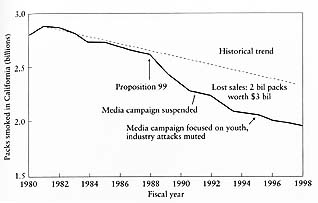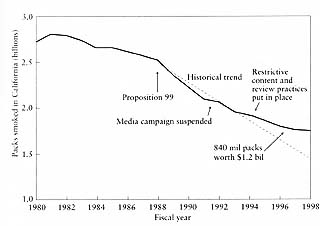Squashing the Media Campaign
The media campaign had been a focal point for controversy ever since the tobacco industry tried to kill it off in 1989 in AB 75, Proposition 99's first implementing legislation (see chapter 5). In 1990 the industry recognized the power of paid counter-advertising and had conducted its own focus group testing of the California advertisements.[6-8] As the implementation of Proposition 99 continued, the media campaign continued to be controversial, with California tobacco control advocates working to maintain a no-holds-barred tone and the tobacco industry and its allies seeking to soften the tone and limit the scope of the campaign to targeting children and pregnant women or else to presenting health messages. Assembly Speaker Curt Pringle (R-Garden Grove) had even attempted to write these restrictions into law in 1996 (see chapter 14).
In 1990 the media campaign got off to a strong start. The first wave of advertisements, launched in April of that year under AB 75, included thirteen television spots and twelve radio spots, supplemented with three more television spots in February 1991. The campaign also included supporting billboards and print advertising. In addition to its aggressive tone, the DHS Tobacco Control Section (TCS) tied the advertising to the needs of the local programs. TCS convened a large Media Advisory Committee, consisting of various stakeholders and representatives of local and ethnic programs, to review emerging advertising concepts and provide feedback.
In January 1992 Governor Wilson tried to eliminate the media campaign by refusing to sign the new contract with the advertising agency, Livingston and Keye (previously keye/donna/perlstein; see chapter 10). The broadcasting of anti-smoking advertisements ended immediately, as did the development of new advertisements. Although the American Lung Association (ALA) successfully sued to force the administration to sign the contract in May 1992, the governor's action significantly disrupted the campaign. Although DHS began running the old advertisements again, no new media was available until February 1993. This delay meant that two years elapsed between waves of new material. Once the
In the fiscal years 1994-1995 and 1995-1996, the Legislature continued to allocate money—nearly $12 million annually—to the media campaign. The allocation, however, did not insure that a quality program would result or even that the money would necessarily be spent. Instead of continuing the Deukmejian administration's policy of treating the development and approval of the advertising spots as a matter to be dealt with by public health professionals inside DHS and its advertising agency, the Wilson administration required the advertisements to be approved by the secretary of health and welfare, Sandra Smoley, and the Governor's Office. As a member of the Sacramento County Board of Supervisors in 1990, Smoley was one of only two votes against the Sacramento Clean Indoor Air Ordinance. The rate of production of new material fell dramatically. Only five television spots were released in September 1994 and four in September 1995. These television spots were supplemented by eleven radio spots. The administration then stopped all production. There were no new advertisements between September 1995 and March 20, 1997. In 1995-1996 the Wilson administration spent only $6.5 million of the $12.2 million appropriated by the Legislature for the media campaign. This $5 million in unspent funds was the $5 million that Speaker Pringle succeeded in allocating to smoking cessation efforts in 1996, effectively cutting the media campaign in half.

Figure 20. Effect of the media campaign on cigarette consumption. After 1994, when Governor Wilson toned down the media campaign and focused on youth, the Tobacco Control Program lost its effectiveness. Even so, from passage in 1988 through 1998, the program prevented about 2 billion packs of cigarettes from being smoked (compared to the historical trend), worth $3 billion to the tobacco industry.
The efforts to squash the media campaign paid off for the tobacco industry. The weakening of the media campaign, in both content and intensity, was associated with an end to the drop in tobacco consumption in California (figure 20). The California Tobacco Survey, conducted in 1998 by John Pierce of the University of California, San Diego, under contract to DHS, demonstrated that smoking stopped falling in California in 1994, at the same time that the funding diversions accelerated and the media campaign and other programs were scaled back and toned down.[3][9] The loss of program effectiveness after 1994 meant that Californians smoked 840 million packs of cigarettes (worth about $1.2 billion to the tobacco industry) between 1994 and 1998 that would not have been smoked had the program remained as effective as it was between 1989 and 1994 (figure 21).

Figure 21. Effect of restrictions on media campaign on cigarette consumption. Wilson Administration policies that scaled back and toned down the anti-tobacco education campaign slowed the decline in cigarette consumption. As a result, 840 million packs of cigarettes, worth $1.2 billion to the tobacco industry, were smoked that would not have been if the early trend had been maintained.